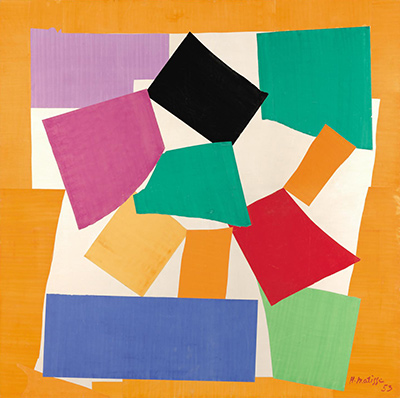The Snail (L'escargot) is a cut-out collage by Henri Matisse which he completed in 1953, the year before he died.
Matisse’s vast paper cut-outs, termed gouache découpées, are among the most notable and revered works of his entire career. Although a bowel cancer diagnosis in 1941 prevented him from painting, he started producing collages in his latter years during a period of convalescence.
To his delight, the collages gave him a newfound artistic freedom, never experienced before. By moving scissors through sheets of paper, he orchestrated a new phase of his career. The technique, discussed in his picture book Jazz published in 1947, opened up new possibilities for him.
Produced by cutting or tearing shapes from paper which had been painted with gouache, The Snail comprises a choppy orange border around a white base and then different coloured shapes on the interior. The shapes were placed and pasted down by an assistant working under Matisse’s instruction at the Hôtel Régina at Nice. Once the composition was finished, the pieces of paper were then sealed down.
Almost three metres square, this large work of art showcases Matisse's talent for harmonising colours and shapes so that blocks of colour appear to float in motion. At this time, Matisse did lots of sketches of snails. The pattern formed by the coloured shapes in the centre of the work echoes the spiral shape found in a snail’s shell.
Matisse combined pairs of contrasting colours –red with green, orange with blue and yellow with mauve – to create a particularly lively effect.
It wasn't until years after his death that Matisse's collages achieved critical acclaim. Colour field painters and minimalists including Ellsworth Kelly, Alma Thomas and Kenneth Noland have continued the reduction to colour work Matisse did in later pieces, of which The Snail can be considered the nearest to contemporary abstract art.
The Snail is displayed in the Tate Gallery collection in London.




